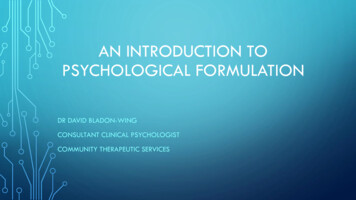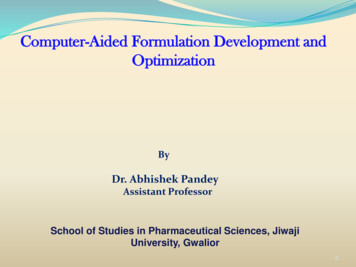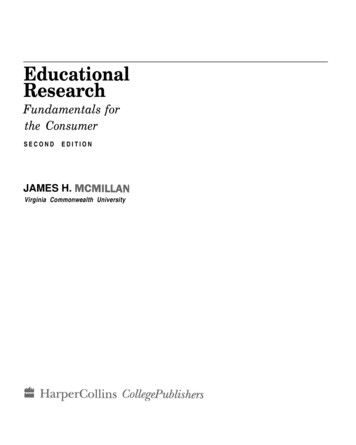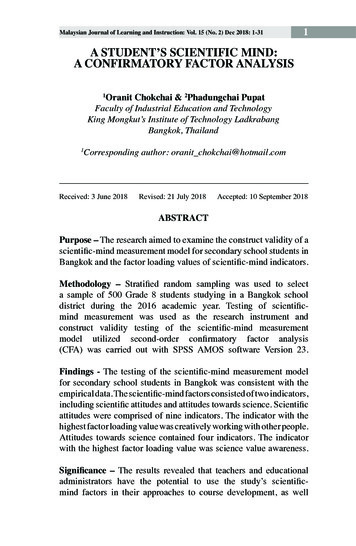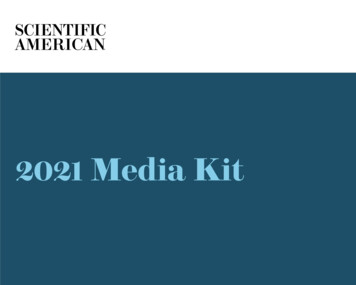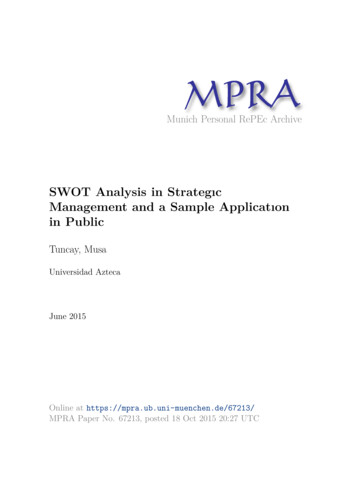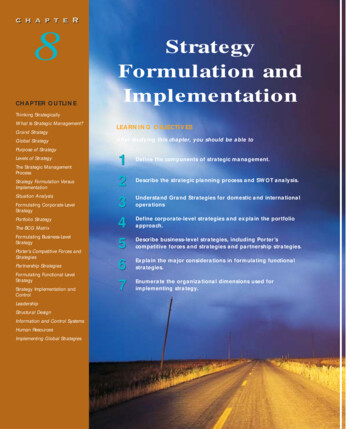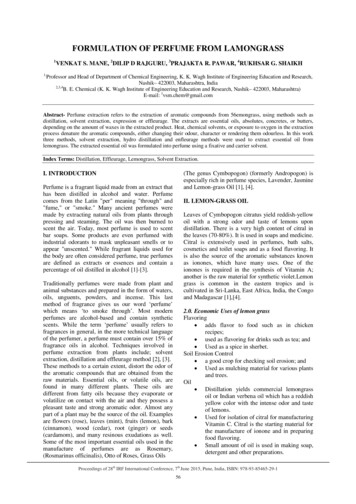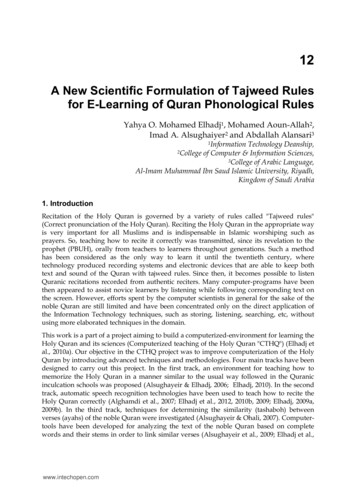
Transcription
12A New Scientific Formulation of Tajweed Rulesfor E-Learning of Quran Phonological RulesYahya O. Mohamed Elhadj1, Mohamed Aoun-Allah2,Imad A. Alsughaiyer2 and Abdallah Alansari31Information Technology Deanship,of Computer & Information Sciences,3College of Arabic Language,Al-Imam Muhammad Ibn Saud Islamic University, Riyadh,Kingdom of Saudi Arabia2College1. IntroductionRecitation of the Holy Quran is governed by a variety of rules called "Tajweed rules"(Correct pronunciation of the Holy Quran). Reciting the Holy Quran in the appropriate wayis very important for all Muslims and is indispensable in Islamic worshiping such asprayers. So, teaching how to recite it correctly was transmitted, since its revelation to theprophet (PBUH), orally from teachers to learners throughout generations. Such a methodhas been considered as the only way to learn it until the twentieth century, wheretechnology produced recording systems and electronic devices that are able to keep bothtext and sound of the Quran with tajweed rules. Since then, it becomes possible to listenQuranic recitations recorded from authentic reciters. Many computer-programs have beenthen appeared to assist novice learners by listening while following corresponding text onthe screen. However, efforts spent by the computer scientists in general for the sake of thenoble Quran are still limited and have been concentrated only on the direct application ofthe Information Technology techniques, such as storing, listening, searching, etc, withoutusing more elaborated techniques in the domain.This work is a part of a project aiming to build a computerized-environment for learning theHoly Quran and its sciences (Computerized teaching of the Holy Quran "CTHQ") (Elhadj etal., 2010a). Our objective in the CTHQ project was to improve computerization of the HolyQuran by introducing advanced techniques and methodologies. Four main tracks have beendesigned to carry out this project. In the first track, an environment for teaching how tomemorize the Holy Quran in a manner similar to the usual way followed in the Quranicinculcation schools was proposed (Alsughayeir & Elhadj, 2006; Elhadj, 2010). In the secondtrack, automatic speech recognition technologies have been used to teach how to recite theHoly Quran correctly (Alghamdi et al., 2007; Elhadj et al., 2012, 2010b, 2009; Elhadj, 2009a,2009b). In the third track, techniques for determining the similarity (tashaboh) betweenverses (ayahs) of the noble Quran were investigated (Alsughayeir & Ohali, 2007). Computertools have been developed for analyzing the text of the noble Quran based on completewords and their stems in order to link similar verses (Alsughayeir et al., 2009; Elhadj et al.,www.intechopen.com
198E-Learning – Engineering, On-Job Training and Interactive Teaching2009c, 2009d). In the fourth track, our focus was on the automatic processing of tajweedrules by proposing a mathematical formulation of these rules that can be easily processed bya machine (Elhadj & Aoun-Allah, 2011; Elhadj et al., 2009e). In this chapter, we discuss howthis kind of formulation was proposed, its advantages and benefits, and how it wasprogrammed in an efficient plug-in engine. The development of an e-learning system fortajweed rules that uses this engine will also be presented. A general integrated environmentfor self-learning of the holy Quran and its sciences including Tajweed will be also brieflyintroduced.This chapter proceeds as follows. Sections 2, 3, and 4 deal with Tajweed where the first onepresents an introduction. Section 3 surveys previous efforts to computerization of Tajweedwhereas Section 4 concentrates on our new formulation. We discuss in Section 5 aprerequisite to our engine of automatic processing of Tajweed rules, which is detailed inSection 6. Our Tajweed Learning System (ETaj) will be presented in the Section 7 and acouple of its important interfaces will be given in Section 8. Finally, before concluding thischapter, we shortly present a global learning environment for Quran and its sciencescomposed of several subsystems including Tajweed teaching system.2. Overview of Tajweed rulesReading of the Holy Quran is quite different from the reading of a normal Arabic text due tothe pronunciation rules that have to be respected during the recitation. As an example,consider the duration of vowels that may vary from 2 to 6 times that of a single consonantdepending on the context. Indeed, there are two kinds of vowels in the Arabic language,short vowels which are keystrokes placed either above or below the preceding consonantand long vowels which denotes a certain repetition of short vowels. There are also othertajweed rules related to:a.b.c.d.e.types of nasalization (called "ghunnah )"غن ,heaviness and lightness (called respectively "tafkheem "تف يم and "tarqeeq )"ت قيق , whichmeans making some sounds emphatic or non-emphatic,types of stops which means making a voiceless break at a Quranic word for a briefmoment (called "waqf )"وقف ,degrees of vibrations or unrest (called "qalqalah )"ق ق which means producing thevoiced stop consonants with a schwa-like sound at the end,etc.To preserve the Holy Quran from any alteration in its pronunciation and then to guaranteeits perfect reading, early Muslim scholars described Quranic recitation methods veryaccurately by textual rules as well as sound ones. These descriptions are classified intocategories depending on some sound properties or features. These categories are oftensummarized as follows:a.b.c.d.e.f.category "Noon sakinah" & "Tanween" ( النو الس كن والتنوين category "Meem sakinah" ( )ب ال يم الس كن category "Qalqalah" ( )ب الق ق category "Tafkheem" & "Tarqeeq" ( )ب التف يم والت قيق category “Al Mad” (lengthening ) ب ال etc.www.intechopen.com )ب
A New Scientific Formulation of Tajweed Rules for E-Learning of Quran Phonological Rules199Each category has a set of rules governing the pronunciation of underlying sounds. Moredetails regarding the classification of Tajweed rules can be obtained from the official site ofKing Fahd Complex for the Printing of Holy Quran at this link: www.qurancomplex.org.3. Previous efforts related to computerization of TajweedTeaching how to apply Tajweed rules during Quranic recitation has been done throughteachers who pronounce the Quranic sounds accurately. With the era of computers, it becomespossible to computerize the learning process of Tajweed, but this need an appropriatedescription of its rules. To the best of our knowledge, there was no attempt to describe themby a scientific algorithm, which could be processed automatically by a machine. This was aconclusion from a large survey we conducted on the Quranic software currently available onthe market, which was published in (Alsughayeir & Elhadj, 2006). The methodology employedto conduct this study consisted of collecting a maximum number of Quranic applications,either for desktop, web-based or hand-held applications. Each application was separatelystudied and evaluated in order to know the characteristics and services it offers.It appeared that softwares developed for the sake of the Holy Quran are still very limitedeither in their objectives or in the term of availability and relevance of features. Regardingthe Tajweed by itself, it was only given as a small part of the surveyed programs. It isoffered, at almost all programs, in a classical manner as textual lessons with some graphicalexplanation of sound production. No dynamic interaction was proposed to allow, neitherefficient learning nor any kinds of intelligent processing.4. New formulation of Tajweed rulesIn order to find a scientific formulation of tajweed rules, we studied them thoroughly withthe assistance of an expert in the domain and finally we came out with the conclusion thatalmost all Tajweed rules described textually by scholars could be written in a scientificmanner and consequently automatically treated by a computer.Our study concluded that to extract the tajweed rule for any letter the maximum number ofwords concerned by the rule is two; i.e. either the previous or the following word. And interms of letters, there are at most 6 letters concerned by the rule which are either precedingor following the letter itself. Moreover, many rules are applicable only to a letter at the endof a word which is easily detectable by comparing the next letter to a space character.For instance, in the category of “Noon Sakinah” & “Tanween” if any letter “Noon Sakinah”or diacritic “Tanween” appears at the end of a word followed by any of these characters “ ي ” و ل ر in the following word then the 2 letters should be assimilated. Moreover, thiscategory is subdivided into two sections where the assimilation could be with “Ghunnah” (asound effect) or without when the letter is followed respectively by “ ” و ي or “ ”ل ر . Weproposed a whole scientific formulation of such textual description of rules into machinereadable rules as indicated in the example in Table 1 taking in consideration the followingnotations:a.b.“C” means the character treated and “S” its diacritic“C 1” or “C-1” represent respectively the character (or characters separated by acomma) immediately following (rep. preceding) the character treated.www.intechopen.com
200c.d.e.f.g.E-Learning – Engineering, On-Job Training and Interactive TeachingAnd in the same way we define “C 2”, “C 3”, or “C-2”, “C-3”, according to theextent of the rule.“*” is used as a wildcard character to replace any letter or diacritic.“Space” represents a space character (between two words).“Text” is human comprehensible message to be displayed to the user if needed.And finally, the “Ruling” of the rule which denotes its name.C *;S ;C 1 Space; S * ;C 2 , , و , ;ي S * ;Text يُ غم التنوين بغن في ح وف C ; S ْ ;C 1 Space; S * ;C 2 , , و , ;ي S *;Text ت غم النو الس كن بغن في ح وف ( ، ، و ، )ي ( ، ، و ، )ي Ruling IdghamGhunnah(Table 1.A)Ruling IdghamGhunnah(Table 1.B)C ; S ْ ;C 1 Space ; S * ;C 2 ;S * ;Text تُ غم ال يم في ال يم إ غ م شفوي C-1 *;S ;C ; ا S * ;C 1 Space ; S * ;C 2 , , و , ;ي S * ;Text بغن في بغن التنوين Ruling IdghamGhunnah( ، ، و ، ح وف)ي (Table 1.C)Ruling IdghamGhunnah(Table 1.D) يُ غم Table 1. Rules describing a couple of cases of assimilation with GhunnahTable 1.A (resp. Table 1.B) describes a rule stating that if any character with a “tanween”diacritic (resp. a “Noon” character with “Sakn” diacritic) at the end of a word followed by aword starting by any of “ ” و ي letters, then there is assimilation with Ghunnah. Table 1.Ddescribes a special case of the rule in Table 1.B where “tanween” is followed by a“lenghthening” at the end of the word. Finally, Table 1.C deals with a “Meem” characterwith “Sakin” diacritic as last letter in a word followed by “Meem” character with anydiacritic as first letter in the next word and where the ruling is the same as previously.Using this technique of writing “tajweed” rules, we finished describing those of 5 mostimportant categories (or chapters): “Al Mad” (lengthening), “qalqala” (unrest), “NoonSakinah” & “Tanween”, “Meem Sakinah”, and "Tafkheem" & "Tarqeeq". This results in atotal number of almost 200 rules. Moreover, any advanced tajweed rule could be easilyadded by writing it as described earlier in the rules text file.Notice that we faced many difficulties in writing our rule set as described above. The mostimportant difficulty was the overlap of rules. This situation happens when more than onerule could be triggered for one letter. For instance, in the word “ ”الس ء we have alengthening of obligatory 4 cycles but when it is the last word in a verse it changes tooptionally 2, 4 or 6 cycles. To overcome this overlap, we added to each rule a priority inorder to avoid the conflict between triggered rules and by choosing only the rule with thehighest priority.www.intechopen.com
A New Scientific Formulation of Tajweed Rules for E-Learning of Quran Phonological Rules2015. Need of a textual version of the Holy Quran with full diacriticsThe Holy Quran is generally written in a special font which could not be edited in texteditor software. Consequently, a text editable version of the Holy Quran that contains nomissing diacritic was necessary to get our automatic processing works correctly. However,this textual editable version as we need it was almost inexistent. Therefore, we looked forthe most agreed version to which we manually added full diacritics and then it was given toscholars for revision and validation.6. Automatic processing of Tajweed rules: Taj Engine (TajE)The Tajweed rule set described in section 4 is interpreted by an inference engine (TajE) ableto deal with our rulings formulation and that can be used alone (See Figure 1) or integratedwith other components for both identification and verification of Tajweed rules in anyQuranic verse (or even any Arabic diacritized text).QuranicVerseTaj EngineTajweedRulingsTajweedRulesFig. 1. Structure of the Taj EngineThis inference engine works like an expert system inference engine in forward chaining andone level inference. In other words, for each character of the treated text, our engine tests allrules once to find the rule or those rules that could be triggered. Conflicting rules are treatedby the rule priority explained in Section 4.As presented earlier, TajE engine could be used either for identification or for verification ofTajweed rulings. The first option (identification) aims to extract Tajweed rulings fromQuranic verses. It is very helpful in different situation, especially to assist a student duringhis memorization of the Holy Quran.The second option (verification) of the TajE engine is to ensure if a Tajweed ruling reallyoccurred in a specific place in the Quranic verse (See Figure 2). This is also a very importantproperty as it can be used in an interactive manner for teaching and correcting Tajweedexercises. A detailed typical exercise scenario is described in the following section.www.intechopen.com
202E-Learning – Engineering, On-Job Training and Interactive TeachingQuranicVerseTaj EngineErrors dRulingsTajweedRulesFig. 2. Taj Engine used for verification7. Tajweed learning system: ETajOur main objective is to design an easy to use e-learning system for Tajweed using ourdeveloped TajE engine. It is intended to be used by students to help them learning, verifyingtheir knowledge, and to train them on Tajweed for the noble intention of correctly recitingthe Holy Quran.The proposed system has been designed to include the following features:a.b.c.General Rules of Recitation and its Ethics: these are stored guidelines about generalrules of recitation like position of stops and their rulings. Reading ethics like “Estiatha ”اإستع and “Basmalah ”ال س , etc. are also included.Tajweed Rulings: this option offers to the student rich text lessons about Tajweedrulings along with examples in text and audio formats. The student could interact withby pausing, stopping or replaying the audio files.Exercises: they cover all Tajweed categories and are taken by student using TajE enginedescribed in the previous section. A typical scenario is given below. Another option forexamination is offered to students to pass examinations in a manner very similar toexercises but in a less helpful way and by assigning a final mark to the learner.Exercises and examination options of ETaj system are implemented as follows:a.b.c.A student starts by choosing the Tajweed category he wants to practice or be tested on.According to his choice, all rulings under the category will be displayed with a specificcolor associated to each ruling.Besides, a verse or a couple of verses chosen randomly will be displayed too. We noticehere that the selection of verses is totally random among all Quran verses and having afixed minimum number of the selected category rulings. This property offers to oursystem a great dynamic aspect. The selection process is either done on the fly bysearching the Holy Quran using first option of the TajE engine to extract verses with theminimum number of rules, or by selecting them from a database of ruling occurrencesalready filled using our TajE engine beforehand. Obviously, the first technique is slowerthan the second but requires less storage space. However, we chose the secondwww.intechopen.com
A New Scientific Formulation of Tajweed Rules for E-Learning of Quran Phonological Rulesd.e.203technique for the simple reason that is the fastest way since a non-negligible treatmentis done beforehand and also to guarantee a good response time for the system.At this moment, the student is invited to select letters where Tajweed rulings appear.This process is achieved by the learner by choosing a color (i.e. a category ruling) andthen selecting the appropriate letters. The student is free to change or to remove hisselections until he decides to validate his choices.Once validated, choices are treated automatically by TajE engine and a report isdisplayed to the student containing the incorrect and missing selections along with thenecessary explanations (i.e. the field “Text” in the rule, See section 4).Figures 3 and 4 show respectively the structure of the proposed ETaj system and itsarchitecture.Moreover, we aim to add to the system a new feature allowing the user to specify the“narration” which will influence all the above features. We mention that our current systemsupports only “Hafs” narration.8. Most important interfaces of the ETaj systemETaj has been designed to be easy to use and to allow great interaction with the user. It isimplemented in the .Net framework using C# and JavaScript as well as other advancedtechnologies. Our database is implemented using MySql as a database management systemas it is free and it offers very excellent features and performance. The most importantinterfaces of the system are introduced in the following sections. التج يد الت رين التج يد التف يم والترقيق الق ق ة ال قط ع وال ص ھ زة ال صل Fig. 3. Structure of the ETaj systemwww.intechopen.com أح آ ا التاوة م رج الحروف الس كنة الن أح ال يم الس كنة أح ال د والقصر
204E-Learning – Engineering, On-Job Training and Interactive TeachingFig. 4. Architecture of the ETaj systemIf we access the system, the following menu will appear to the user:Fig. 5. Main menu of the ETaj systemwww.intechopen.com
A New Scientific Formulation of Tajweed Rules for E-Learning of Quran Phonological Rules205From this main menu, we can navigate to different options in the system. If we click, forexample one of the tajweed rulings, a page like the following is displayed:Fig. 6. Tajweed rulings pageThree main parts are enclosed in this page: one for the tajweed category and its rulings thatcan be navigated one after another (Figure 6 (a)), the content of the current ruling (Figure 6(b)), and examples of the ruling (Figure 6 (c)):Fig. 6(a). Tajweed category and its rulingswww.intechopen.com
206E-Learning – Engineering, On-Job Training and Interactive TeachingFig. 6(b). Content of a rulingFig. 6(c). Examples of a tajweed rulingNow, if we click on the "exercises" option, we will be redirected to a page where we canchoose the category of tajweed we want to practice (Figure 7):Fig. 7. Exercise selection pageOnce the category is selected, a page like that of Figure 8 is displayed and the user is askedto navigate the category rulings and to select their occurrences in the ayah that has beenrandomly chosen. This is done in the same manner as explained previously in section 7.www.intechopen.com
A New Scientific Formulation of Tajweed Rules for E-Learning of Quran Phonological Rules207Fig. 8. Exercise pageAfter finishing determining places of ruling occurrences, a page result (see Figure 9) isdisplayedFig. 9. Page Result9. General integrated environment for self-learning of the Holy QuranThe Tajweed learning system is a part of a fully integrated environment developed for selflearning of the holy Quran and its sciences. This environment comprises four subsystems inaddition to the ETaj system: subsystem for learning how to recite and memorise the holyQuran, subsystem for studying the similarity between Quranic terms and verses, subsystemproviding the most relevant features that learners of the holy Quran may need such as(Erab" "اإع ا , Nuzoul “ النزول ”اس , Tafseer “ ”التفسي , Ejaz“ ”اإعج الع ي , etc.), and finally areach library providing authentic sources from which the relevant features are taken. Thethree main subsystems will be briefly described in the following sections to get picture ofthis environment.9.1 The memorization subsystem: E-halagaThe E-halaga system is designed based-on the Quran memorization halaga “ ”ح ق تحفيظ الق آ approach (E-halaga means electronic halaga). It simulates the real one in having tutors,www.intechopen.com
208E-Learning – Engineering, On-Job Training and Interactive Teachingsupervisor, and registered students. E-halaga allows four main types of users with specificroles: administrator, supervisor, tutor, and student. Roles are distributed hierarchically toallow a great flexibility over the system. The creation of the E-halaga is done by itssupervisor, which is in turn created by the system administrator. The supervisor isresponsible of running the E-halaga in terms of adding or deleting tutors, distributinglearners, etc.Since the E-halaga is a simulation of the real halaga, the learner have to specify a dailyamount (memorization section) to be memorized starting from somewhere in the Quran(starting ayah/page). As the learner progresses, he needs to have in parallel a revisionprogram for the memorized parts to improve their quality (revision section). So, theregistration in the E-halaga system requires specifying the following parameters: startingayah/page, memorization section and its length, revision section and its length (at least thedouble of the memorization section), and previously memorized sections before joining thesystem.Once registered, the learner will obtain a user name and password to access the system. If helogs into the system, he will be redirected to the memorization/revision part where he canfind a list of useful options. He can browse his own profile and change it as needed,measure his performance (number of sections perfected, times of failure in every section,duration of memorizing), print out his transcript, etc. The learner can listen to an idealrecitation taken from one of the famous reciters stored in the system as a reference forperfect recitation. After listening to the reference recitation several times, or reciting directly,the learner can test his memory by clicking on an icon to record the section. Then the pagesof the section will disappear to test his memory. Clicking on the button of “end recording”will display again the section pages allowing the learner to verify his memorization. Thelearner can repeat this process (recording and verifying) till the perfection of memorization.Once the learner approves his recording, the audio file is uploaded to the server and thelearner will not be able to modify it. The tutor is then notified with an unmarked recordedsection of that learner. After the tutor marks the section, the learner can benefit from audioand/or textual remarks explaining his mistakes. Figure 10 shows the architecture of the Ehalaga system and we invite the reader to consult (Elhadj, 2010) for more details.9.2 The similarity search engineThe similarity search engine is a component devoted to determine the similarity betweenQuranic verses (and Quranic terms). To build this system, we started preparing an authenticfully diacritised textual version of the Holy Quran since such one was not available for theuse in the domain of research. Next, the focus was on a manual morphological analysis ofthis version. Each word in the Holy Quran is split into four parts, prefixes, stem, root andsuffixes, and then stored in an indexed database. Words are kept in their original context,which means Quranic verses (Elhadj et al., 2009c, 2009d). A semi-automatic environment formorphological analysis has been developed (see figure 11). Full-text searching techniqueswere investigated and then computer-programs have been developed for analyzing the textof the noble Quran based on complete words and their stems in order to link similarverses (Alsughayeir & Ohali, 2007; Alsughayeir et al., 2009). Figure 12 shows the engineinterface.www.intechopen.com
A New Scientific Formulation of Tajweed Rules for E-Learning of Quran Phonological RulesFig. 10. E-halaga architectureFig. 11. Interface of the Semi-automatic Morphological Analyzerwww.intechopen.com209
210E-Learning – Engineering, On-Job Training and Interactive TeachingFig. 12. Interface of the Similarity Search EngineFig. 12(a). Interface of the Quran Sciences Subsystem9.3 The Quran sciences subsystemIt is a system letting the user navigates the Holy Quran and its main sciences. The mainfeatures offered are taken from authentic books, which were linked with the holy Quranthrough a full indexing of Quranic ayahs using advanced techniques and methodologies.Information are kept in their original sources (books), but can be easily retrieved andquickly processed. The books can be navigated, downloaded, etc., from a library, whichrepresents another subsystem of this environment. Possibility of updates is well considered.www.intechopen.com
A New Scientific Formulation of Tajweed Rules for E-Learning of Quran Phonological Rules21110. ConclusionIn this chapter, we firstly presented our work related to the textual specification of Tajweedrules in order to come up with a machine-readable formulation of these rules. Anappropriate and easily extendable rule set has then been proposed. A fully diacriticisedtextual version of the Holy Quran has also been prepared to be used with our new-tajweedformulations. Next, we focused on the implementation of these formulations in a fast andefficient plug-in Tajweed Engine (TajE) that can be integrated in different kinds of systemsfor teaching the Holy Quran and its sciences. TajE is able to handle rulings in two differentways: identification and verification. The identification option is intended to extract Tajweedrulings from Quranic verses. The verification option, may serve to ensure that a specificTajweed ruling really occurred in a certain place in the Quranic verse, which is very useful.An e-learning system for self learning of tajweed (ETaj) is next built on the top of thetajweed engine (TajE). It provides different options allowing learners to get maximumbenefit. The first important option of the system gives general rules and ethics of learningthe Holy Quran. The second option offers a well designed component for learning tajweedrulings using a convenient and attractive manner of presenting the content of rulings alongwith textual examples as well as sound ones. The third option is very important as itprovides a full dynamic interaction with the system to practice tajweed rulings.At our best knowledge, both TajE and ETaj systems are the first of their kinds developed forautomatic processing of Tajweed in a full interactive manner. They are now ready to be usedand can help mastering this important field of Quranic Sciences.11. Future worksIn near future, we plan to improve ETaj system by organizing tajweed rulings in levels withincremental degree of complexity as it is followed in the real teaching of tajweed. Learnershave to go through levels one by one. At the end of each level a self examination or testingwill be initiated by the system and the learner will not be allowed to go further until hemasters the current level. This means that a kind of authentication needs to be added to thesystem to follow students in their process of learning.As another future work, we plan to expand our TajE engine to cover other Quranicnarrations as we currently covered just "Hafs" narration.12. AcknowledgementsThis work was supported by King Abdulaziz City for Sciences and Technology(www.kacst.edu.sa), as part of the CTHQ Project, under the grant number AT-25-113, SaudiArabia. We thank all the other project team members, which actively participated in theelaboration of the whole project.13. ReferencesAlghamdi, M., Elhadj, Y.O.M., & Alkanhal, M. (2007). Manual System to Segment andTranscribe Arabic Speech, Proceedings of IEEE/ICSPC'07, Dubai, UAE, November24-27, 2007.www.intechopen.com
212E-Learning – Engineering, On-Job Training and Interactive TeachingAlsughayeir, I.A., Khorsi, A.M., Alansari, A.M., & Ohali, Y.M. (2009). Search Engine for thesimilarity in Quranic Terms (in Arabic), Proceedings of Int. Conf. on the GloriousQuran and Contemporary Technologies, King Fahd Complex for the Printing of theHoly Quran, Almadinah, Saudi Arabia, October 13-15, 2009.Alsughayeir, I.A. & Ohali, Y.M. (2007). Similarity in Quranic Terms: computer-study (inArabic), Proceedings of ITRAS'07, Riyadh, Saudi Arabia, March 6-7, 2007.Alsughayeir, I.A. & Elhadj, Y.O.M. (2006). Computerized Quran Products: State-Of-Art (inArabic), Proceedings of STCEX'06, Riyadh, Saudi Arabia, December 2-6, 2006.Elhadj, Y.O.M., Alghamdi, M., AlKanhal, M. & Alansari, A.M. (2012). Towards anAutomatic Corrector of Quranic Recitation Integreated within an Environment forSelf-Learning of the Holy Quran (In Arabic). To be appeared in Computer ResearchJournal published by the Federation of Arab Scientific Research Councils, Vol. 11, No.1.Elhadj, Y.O.M. & Aoun-Allah, M. (2011). A Machine-Readable Formulation of TajweedRules for Fast & Efficient Processing, Proceedings of the ICIST'11 InternationalConference, tebessa, Algeria, April 24-26, 2011Elhadj, Y.O.M., Alsughayeir, I.A., Alghamdi, M., Alkanhal, M., Ohali, Y.M. & Alansari, A.M.(2010). Computerized teaching of the Holy Quran (in Arabic), Final Te
tajweed rules that uses this engine will also be presented. A general integrated environment for self-learning of the holy Quran and its sciences including Tajweed will be also briefly introduced. This chapter proceeds as follows. Sections 2, 3, and 4 deal with Tajweed where the first one presents an introduction.
